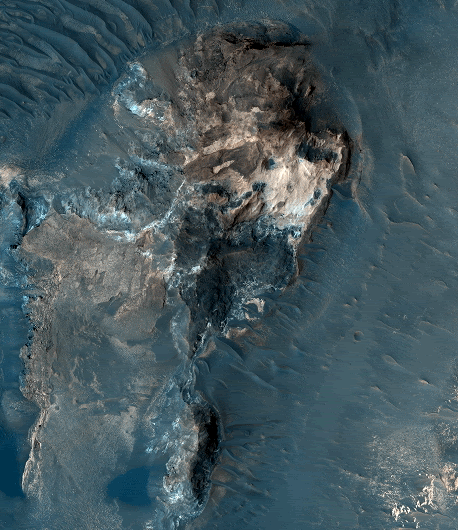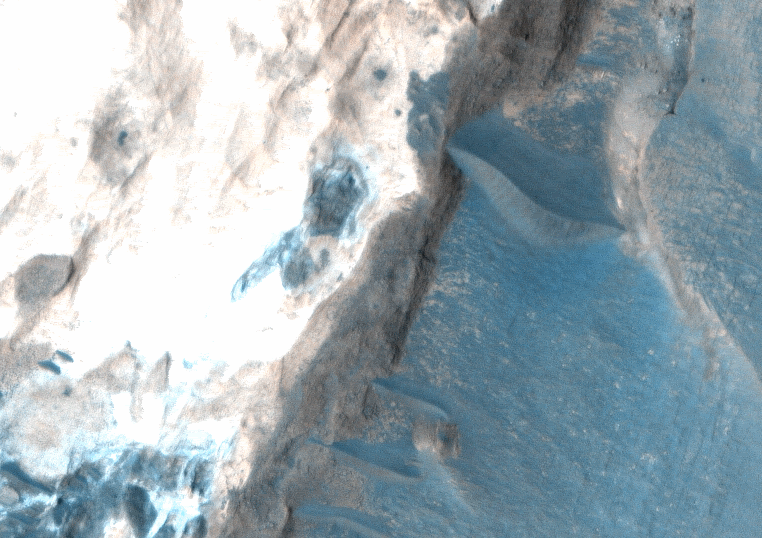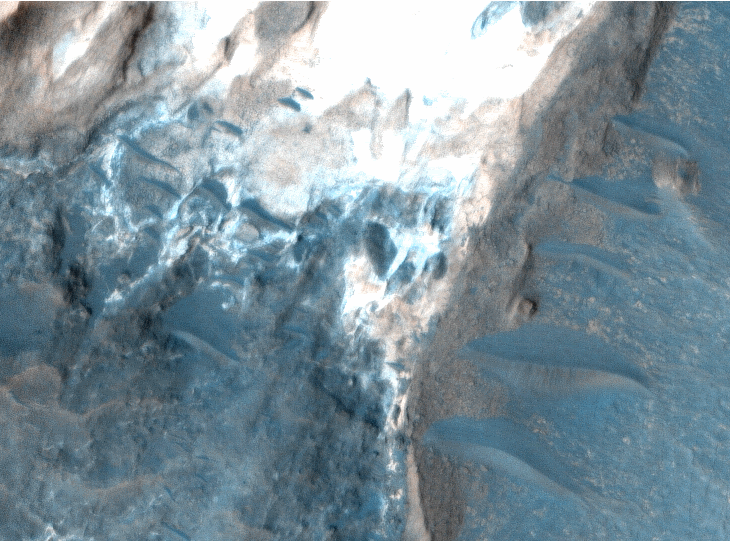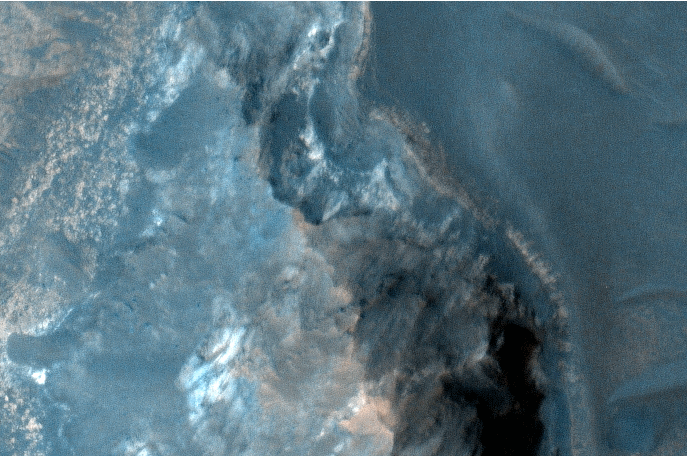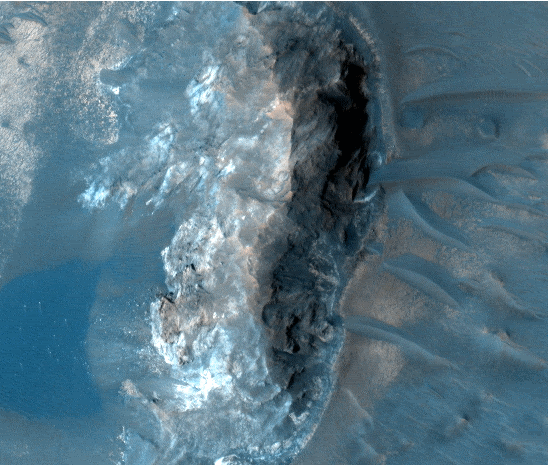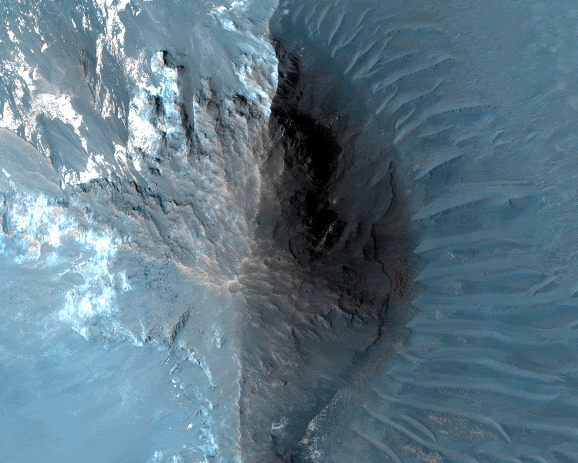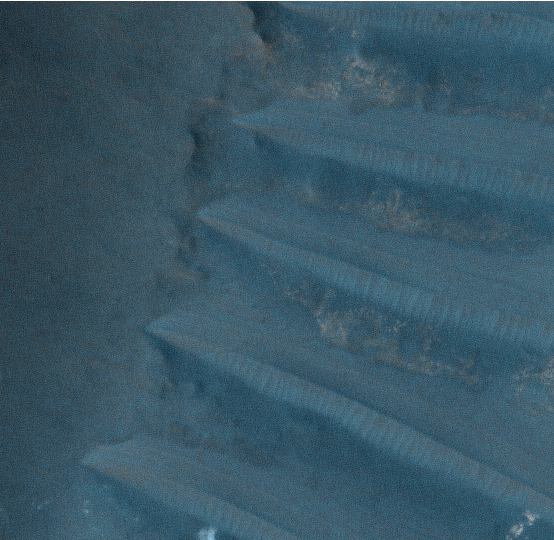- Thank you received: 0
Faces from the Chasmas
- neilderosa
-
- Offline
- Platinum Member
-

Less
More
16 years 8 months ago #20382
by neilderosa
Replied by neilderosa on topic Reply from Neil DeRosa
I am not pretending that this demonstration is proof of artificiality on Mars, merely that it is a possible line of evidence.
Here is Prometheus once more as a context for the following crops in close up.
Brown clay-like border of crown area
Border of forehead area
Forehead to nose area with brown border continued, eye detail and nose and cheek contours
Here is the right shoulder area, also bordered
As a contrast here are natural outcroppings just to the south without brown border against white clay-like material, but we can see the common tube-like dunes abutting the outcropping.
Neil DeRosa
Here is Prometheus once more as a context for the following crops in close up.
Brown clay-like border of crown area
Border of forehead area
Forehead to nose area with brown border continued, eye detail and nose and cheek contours
Here is the right shoulder area, also bordered
As a contrast here are natural outcroppings just to the south without brown border against white clay-like material, but we can see the common tube-like dunes abutting the outcropping.
Neil DeRosa
Please Log in or Create an account to join the conversation.
16 years 8 months ago #15373
by rderosa
Replied by rderosa on topic Reply from Richard DeRosa
<blockquote id="quote"><font size="2" face="Verdana, Arial, Helvetica" id="quote">quote:<hr height="1" noshade id="quote"><i>Originally posted by neilderosa</i>
<br />Theoretically, it should not be very hard to tell anomalous formations from natural formations, with images of this kind of resolution at our disposal and an algorithm that is spectrographically calibrated as the RGB and IRB color schemes have been indicated to be.<hr height="1" noshade id="quote"></blockquote id="quote"></font id="quote">Then do it. Personally, I'm not sure what theory you're talking about, but if you know, then perhaps you're best equipped to do the job.
<blockquote id="quote"><font size="2" face="Verdana, Arial, Helvetica" id="quote">quote:<hr height="1" noshade id="quote">That no one is presently making the effort (that I know of) is not surprising. neilderosa<hr height="1" noshade id="quote"></blockquote id="quote"></font id="quote"> It doesn't seem like anyone is preventing anyone from making the effort, either. I would think most real scientists are busy working on the things that got them to where they are. If someone with a somewhat far out theory truly wanted to impress on the scientific community that they have discovered something of value, it's incumbent on them to make the case.
There may be a number of people out there who are sympathetic to your cause, and may actually have seen your posts and think you may be on to something. But I doubt if they would take up the mantle of leadership on the subject of yours or anyone else's finds. For one thing, what good would it do them, and for another, there's a strong possibility that these too are pareidolic images. Somewhat more elaborate, true, but like Tom has said from the beginning, there is no level of "it looks elaborate to me" that in and of itself proves anything. So, from a scientific viewpoint, it's no different than a teddy bear in the clouds until someone proves otherwise.
rd
<br />Theoretically, it should not be very hard to tell anomalous formations from natural formations, with images of this kind of resolution at our disposal and an algorithm that is spectrographically calibrated as the RGB and IRB color schemes have been indicated to be.<hr height="1" noshade id="quote"></blockquote id="quote"></font id="quote">Then do it. Personally, I'm not sure what theory you're talking about, but if you know, then perhaps you're best equipped to do the job.
<blockquote id="quote"><font size="2" face="Verdana, Arial, Helvetica" id="quote">quote:<hr height="1" noshade id="quote">That no one is presently making the effort (that I know of) is not surprising. neilderosa<hr height="1" noshade id="quote"></blockquote id="quote"></font id="quote"> It doesn't seem like anyone is preventing anyone from making the effort, either. I would think most real scientists are busy working on the things that got them to where they are. If someone with a somewhat far out theory truly wanted to impress on the scientific community that they have discovered something of value, it's incumbent on them to make the case.
There may be a number of people out there who are sympathetic to your cause, and may actually have seen your posts and think you may be on to something. But I doubt if they would take up the mantle of leadership on the subject of yours or anyone else's finds. For one thing, what good would it do them, and for another, there's a strong possibility that these too are pareidolic images. Somewhat more elaborate, true, but like Tom has said from the beginning, there is no level of "it looks elaborate to me" that in and of itself proves anything. So, from a scientific viewpoint, it's no different than a teddy bear in the clouds until someone proves otherwise.
rd
Please Log in or Create an account to join the conversation.
- neilderosa
-
- Offline
- Platinum Member
-

Less
More
- Thank you received: 0
16 years 8 months ago #15374
by neilderosa
Replied by neilderosa on topic Reply from Neil DeRosa
<blockquote id="quote"><font size="2" face="Verdana, Arial, Helvetica" id="quote">quote:<hr height="1" noshade id="quote"><i>Originally posted by rderosa</i>
<br /><blockquote id="quote"><font size="2" face="Verdana, Arial, Helvetica" id="quote">quote:<hr height="1" noshade id="quote"><i>Originally posted by neilderosa</i>
<br />Theoretically, it should not be very hard to tell anomalous formations from natural formations, with images of this kind of resolution at our disposal and an algorithm that is spectrographically calibrated as the RGB and IRB color schemes have been indicated to be.<hr height="1" noshade id="quote"></blockquote id="quote"></font id="quote">Then do it. Personally, I'm not sure what theory you're talking about, but if you know, then perhaps you're best equipped to do the job.
<blockquote id="quote"><font size="2" face="Verdana, Arial, Helvetica" id="quote">quote:<hr height="1" noshade id="quote">That no one is presently making the effort (that I know of) is not surprising. neilderosa<hr height="1" noshade id="quote"></blockquote id="quote"></font id="quote"> It doesn't seem like anyone is preventing anyone from making the effort, either. I would think most real scientists are busy working on the things that got them to where they are. If someone with a somewhat far out theory truly wanted to impress on the scientific community that they have discovered something of value, it's incumbent on them to make the case.
There may be a number of people out there who are sympathetic to your cause, and may actually have seen your posts and think you may be on to something. But I doubt if they would take up the mantle of leadership on the subject of yours or anyone else's finds. For one thing, what good would it do them, and for another, there's a strong possibility that these too are pareidolic images. Somewhat more elaborate, true, but like Tom has said from the beginning, there is no level of "it looks elaborate to me" that in and of itself proves anything. So, from a scientific viewpoint, it's no different than a teddy bear in the clouds until someone proves otherwise.
rd
<hr height="1" noshade id="quote"></blockquote id="quote"></font id="quote">
Perhaps I should change "not very hard" to "possible." Discovery of the specific composition of an artifact in relation to the surrounding terrain, how it was disturbed, how that disturbance compares to the surrounding area. All these have been typical methods of archeologists and I assume also geologists.
To address the "looks like" objection; Ive never agreed that this can be no part of the investigation, though of course it should not be the only one. If an archeologist digs up ancient bones or the ruins of a city, he should not ignore what he sees (that would be like working blindfolded). But after making a tentative guess at what he has found (based on his expertise, common sense and experience) he proceeds to do the scientific tests.
[Neil]
Here is an excerpt from an article where this kind of thing is being done.
<blockquote id="quote"><font size="2" face="Verdana, Arial, Helvetica" id="quote">quote:<hr height="1" noshade id="quote">This image of phyllosilicates and olivine in the Nili Fossae region of Mars was taken by the Compact Reconnaissance Imaging Spectrometer for Mars (CRISM) at 0714UTC (3:14 a.m. EDT) on October 3, 2006 near 20.5 degrees north latitude, 78.5 degrees east longitude. The image was taken in 544 colors covering 0.36-3.92 micrometers, and shows features as small as 18 meters (60 feet) across.
Nili Fossae is a group of long, narrow depressions comprised of a series of grabens or down-dropped blocks of crust surrounded by faults. It lies to the northeast of Syrtis Major (a low and broad shield volcano) and to the northwest of an impact basin, Isidis Planitia. Nili Fossae stretches some 667 kilometers (415 miles) toward Utopia Planitia, and has been partially filled by sediments and volcanic lavas.
The High-Resolution Imaging Science Experiment (HiRISE), which is also onboard the Mars Reconnaissance Orbiter, has imaged similar regions elsewhere in Nili Fossae. When combined with CRISM data, the images revealed the sand dunes to be olivine-rich and commonly lying atop clay deposits
crism.jhuapl.edu/gallery/featuredImage/i...ry_id=2&image_id=142
<hr height="1" noshade id="quote"></blockquote id="quote"></font id="quote">
<br /><blockquote id="quote"><font size="2" face="Verdana, Arial, Helvetica" id="quote">quote:<hr height="1" noshade id="quote"><i>Originally posted by neilderosa</i>
<br />Theoretically, it should not be very hard to tell anomalous formations from natural formations, with images of this kind of resolution at our disposal and an algorithm that is spectrographically calibrated as the RGB and IRB color schemes have been indicated to be.<hr height="1" noshade id="quote"></blockquote id="quote"></font id="quote">Then do it. Personally, I'm not sure what theory you're talking about, but if you know, then perhaps you're best equipped to do the job.
<blockquote id="quote"><font size="2" face="Verdana, Arial, Helvetica" id="quote">quote:<hr height="1" noshade id="quote">That no one is presently making the effort (that I know of) is not surprising. neilderosa<hr height="1" noshade id="quote"></blockquote id="quote"></font id="quote"> It doesn't seem like anyone is preventing anyone from making the effort, either. I would think most real scientists are busy working on the things that got them to where they are. If someone with a somewhat far out theory truly wanted to impress on the scientific community that they have discovered something of value, it's incumbent on them to make the case.
There may be a number of people out there who are sympathetic to your cause, and may actually have seen your posts and think you may be on to something. But I doubt if they would take up the mantle of leadership on the subject of yours or anyone else's finds. For one thing, what good would it do them, and for another, there's a strong possibility that these too are pareidolic images. Somewhat more elaborate, true, but like Tom has said from the beginning, there is no level of "it looks elaborate to me" that in and of itself proves anything. So, from a scientific viewpoint, it's no different than a teddy bear in the clouds until someone proves otherwise.
rd
<hr height="1" noshade id="quote"></blockquote id="quote"></font id="quote">
Perhaps I should change "not very hard" to "possible." Discovery of the specific composition of an artifact in relation to the surrounding terrain, how it was disturbed, how that disturbance compares to the surrounding area. All these have been typical methods of archeologists and I assume also geologists.
To address the "looks like" objection; Ive never agreed that this can be no part of the investigation, though of course it should not be the only one. If an archeologist digs up ancient bones or the ruins of a city, he should not ignore what he sees (that would be like working blindfolded). But after making a tentative guess at what he has found (based on his expertise, common sense and experience) he proceeds to do the scientific tests.
[Neil]
Here is an excerpt from an article where this kind of thing is being done.
<blockquote id="quote"><font size="2" face="Verdana, Arial, Helvetica" id="quote">quote:<hr height="1" noshade id="quote">This image of phyllosilicates and olivine in the Nili Fossae region of Mars was taken by the Compact Reconnaissance Imaging Spectrometer for Mars (CRISM) at 0714UTC (3:14 a.m. EDT) on October 3, 2006 near 20.5 degrees north latitude, 78.5 degrees east longitude. The image was taken in 544 colors covering 0.36-3.92 micrometers, and shows features as small as 18 meters (60 feet) across.
Nili Fossae is a group of long, narrow depressions comprised of a series of grabens or down-dropped blocks of crust surrounded by faults. It lies to the northeast of Syrtis Major (a low and broad shield volcano) and to the northwest of an impact basin, Isidis Planitia. Nili Fossae stretches some 667 kilometers (415 miles) toward Utopia Planitia, and has been partially filled by sediments and volcanic lavas.
The High-Resolution Imaging Science Experiment (HiRISE), which is also onboard the Mars Reconnaissance Orbiter, has imaged similar regions elsewhere in Nili Fossae. When combined with CRISM data, the images revealed the sand dunes to be olivine-rich and commonly lying atop clay deposits
crism.jhuapl.edu/gallery/featuredImage/i...ry_id=2&image_id=142
<hr height="1" noshade id="quote"></blockquote id="quote"></font id="quote">
Please Log in or Create an account to join the conversation.
16 years 8 months ago #20324
by rderosa
Replied by rderosa on topic Reply from Richard DeRosa
The problem with the archaeologist analogy is that here on Earth there is no question about whether or not intelligent beings existed here in the past. On Mars, not only is there a real question, but the folks in charge of the investigation seem to dismiss it out of hand.
I see what you're getting at with the CRISM. True, I would think they could "easily" investigate your site and come up with a reasonable guess as to how and whether it formed naturally. But again, they're not looking for artworks and are not likely to start anytime soon, so there in lies the dilemma for the people who think there are artworks.
Basically, you just proved my point for me. I didn't know about the CRISM before, but it's an example of the problem you face, and why you might have to come up with your own method of proving it.
Or another approach that might have some level of success would be to contact someone at JPL or Arizona State University directly and make your case. I've found them to be easy to reach, and quite willing to discuss things. See if you can't stir up some interest with the people who make the decisions about what gets studied. There's mention of a "CRISM Principal Investigator S. Murchie " that might be a place to start. You could show some of your most promising finds, with a plea for a certain amount of concern for the possibility that you're right, "look at these images, they are way too elaborate to be pareidolic, therefore they must be artworks from some ancient past civilization on Mars. How could you possiblly not be interested in finding out if that's true?" Or something to that effect. You might just get lucky and find the one person who could bend a little.
After all, I can't believe that every single scientist on the face of the Earth has their head in the sand, and would refuse to look at something that you believe is that promising. That's a little hard to believe.
Anyway, I still think the onus is on you to somehow get the ball rolling. The colored Prometheus is probably the best candidate you have going for you, if that doesn't get someone's attention, I can't imagine what would. Like I said, it still could be pareidolia, but it's harder to believe it is, in this case.
Meahwhile, you might want to figure out a better way of protecting your finds rather than just have them posted here (or maybe you already did that), just in case all of a sudden some mainstream scientist proves there was once living beings like ourselves on Mars (I suppose anything is possible). One could imagine in such a case that there would be a mad scramble to "claim" various artifacts.
rd
I see what you're getting at with the CRISM. True, I would think they could "easily" investigate your site and come up with a reasonable guess as to how and whether it formed naturally. But again, they're not looking for artworks and are not likely to start anytime soon, so there in lies the dilemma for the people who think there are artworks.
Basically, you just proved my point for me. I didn't know about the CRISM before, but it's an example of the problem you face, and why you might have to come up with your own method of proving it.
Or another approach that might have some level of success would be to contact someone at JPL or Arizona State University directly and make your case. I've found them to be easy to reach, and quite willing to discuss things. See if you can't stir up some interest with the people who make the decisions about what gets studied. There's mention of a "CRISM Principal Investigator S. Murchie " that might be a place to start. You could show some of your most promising finds, with a plea for a certain amount of concern for the possibility that you're right, "look at these images, they are way too elaborate to be pareidolic, therefore they must be artworks from some ancient past civilization on Mars. How could you possiblly not be interested in finding out if that's true?" Or something to that effect. You might just get lucky and find the one person who could bend a little.
After all, I can't believe that every single scientist on the face of the Earth has their head in the sand, and would refuse to look at something that you believe is that promising. That's a little hard to believe.
Anyway, I still think the onus is on you to somehow get the ball rolling. The colored Prometheus is probably the best candidate you have going for you, if that doesn't get someone's attention, I can't imagine what would. Like I said, it still could be pareidolia, but it's harder to believe it is, in this case.
Meahwhile, you might want to figure out a better way of protecting your finds rather than just have them posted here (or maybe you already did that), just in case all of a sudden some mainstream scientist proves there was once living beings like ourselves on Mars (I suppose anything is possible). One could imagine in such a case that there would be a mad scramble to "claim" various artifacts.
rd
Please Log in or Create an account to join the conversation.
- neilderosa
-
- Offline
- Platinum Member
-

Less
More
- Thank you received: 0
16 years 8 months ago #20232
by neilderosa
Replied by neilderosa on topic Reply from Neil DeRosa
<blockquote id="quote"><font size="2" face="Verdana, Arial, Helvetica" id="quote">quote:<hr height="1" noshade id="quote"><i>Originally posted by marsrocks</i>
<br /><blockquote id="quote"><font size="2" face="Verdana, Arial, Helvetica" id="quote">quote:<hr height="1" noshade id="quote">"Water is a key condition for life as we know it. Though there is no firm evidence that Mars has ever harbored life, knowing that the planet was once wet suggests that it was at least habitable in the past.
The key to the finding is the discovery that rocks called phyllosilicates are widespread on at least the planet's southern hemisphere. The water present on Mars from about 4.6 billion to 3.8 billion years ago transformed some rocks into these phyllosilicates,..."<hr height="1" noshade id="quote"></blockquote id="quote"></font id="quote">
[url] www.space.com/scienceastronomy/080716-mars-water.html [/url]
<hr height="1" noshade id="quote"></blockquote id="quote"></font id="quote">
It is important to point out that the dates cited in the above post are derived from the conventional scheme of Mars' crustal evolution which basically derives from "crater counting" (as on the earth's Moon) The exploded planet hypothesis postulates much more recent events as having caused the majority of the craters we now see on Mars. Many of the much older craters were probably covered by sediment and other geological evolutionary events as they were on earth. This means that the observed long-term presence of water noted in the quote could have been much more recently ended by the catastrophic EPH events. This allows for the possibility of life to have existed on Mars a mere few million years ago rather than billions, as in the conventional theory. [Neil]
(see "Why Mars has two unlike hemispheres" in the "Meta Science in the News" section of the current MRB metaresearch.org/publications/bulletin/2...es/0801/Mrb08ap6.asp )
<br /><blockquote id="quote"><font size="2" face="Verdana, Arial, Helvetica" id="quote">quote:<hr height="1" noshade id="quote">"Water is a key condition for life as we know it. Though there is no firm evidence that Mars has ever harbored life, knowing that the planet was once wet suggests that it was at least habitable in the past.
The key to the finding is the discovery that rocks called phyllosilicates are widespread on at least the planet's southern hemisphere. The water present on Mars from about 4.6 billion to 3.8 billion years ago transformed some rocks into these phyllosilicates,..."<hr height="1" noshade id="quote"></blockquote id="quote"></font id="quote">
[url] www.space.com/scienceastronomy/080716-mars-water.html [/url]
<hr height="1" noshade id="quote"></blockquote id="quote"></font id="quote">
It is important to point out that the dates cited in the above post are derived from the conventional scheme of Mars' crustal evolution which basically derives from "crater counting" (as on the earth's Moon) The exploded planet hypothesis postulates much more recent events as having caused the majority of the craters we now see on Mars. Many of the much older craters were probably covered by sediment and other geological evolutionary events as they were on earth. This means that the observed long-term presence of water noted in the quote could have been much more recently ended by the catastrophic EPH events. This allows for the possibility of life to have existed on Mars a mere few million years ago rather than billions, as in the conventional theory. [Neil]
(see "Why Mars has two unlike hemispheres" in the "Meta Science in the News" section of the current MRB metaresearch.org/publications/bulletin/2...es/0801/Mrb08ap6.asp )
Please Log in or Create an account to join the conversation.
16 years 8 months ago #15403
by gorme
Replied by gorme on topic Reply from Greg Orme
<blockquote id="quote"><font size="2" face="Verdana, Arial, Helvetica" id="quote">quote:<hr height="1" noshade id="quote"><i>Originally posted by neilderosa</i>
<br /><blockquote id="quote"><font size="2" face="Verdana, Arial, Helvetica" id="quote">quote:<hr height="1" noshade id="quote"><i>Originally posted by rderosa</i>
<br /><blockquote id="quote"><font size="2" face="Verdana, Arial, Helvetica" id="quote">quote:<hr height="1" noshade id="quote"><i>Originally posted by neilderosa</i>
<br />Theoretically, it should not be very hard to tell anomalous formations from natural formations, with images of this kind of resolution at our disposal and an algorithm that is spectrographically calibrated as the RGB and IRB color schemes have been indicated to be.<hr height="1" noshade id="quote"></blockquote id="quote"></font id="quote">Then do it. Personally, I'm not sure what theory you're talking about, but if you know, then perhaps you're best equipped to do the job.
<blockquote id="quote"><font size="2" face="Verdana, Arial, Helvetica" id="quote">quote:<hr height="1" noshade id="quote">That no one is presently making the effort (that I know of) is not surprising. neilderosa<hr height="1" noshade id="quote"></blockquote id="quote"></font id="quote"> It doesn't seem like anyone is preventing anyone from making the effort, either. I would think most real scientists are busy working on the things that got them to where they are. If someone with a somewhat far out theory truly wanted to impress on the scientific community that they have discovered something of value, it's incumbent on them to make the case.
There may be a number of people out there who are sympathetic to your cause, and may actually have seen your posts and think you may be on to something. But I doubt if they would take up the mantle of leadership on the subject of yours or anyone else's finds. For one thing, what good would it do them, and for another, there's a strong possibility that these too are pareidolic images. Somewhat more elaborate, true, but like Tom has said from the beginning, there is no level of "it looks elaborate to me" that in and of itself proves anything. So, from a scientific viewpoint, it's no different than a teddy bear in the clouds until someone proves otherwise.
rd
<hr height="1" noshade id="quote"></blockquote id="quote"></font id="quote">
Perhaps I should change "not very hard" to "possible." Discovery of the specific composition of an artifact in relation to the surrounding terrain, how it was disturbed, how that disturbance compares to the surrounding area. All these have been typical methods of archeologists and I assume also geologists.
To address the "looks like" objection; Ive never agreed that this can be no part of the investigation, though of course it should not be the only one. If an archeologist digs up ancient bones or the ruins of a city, he should not ignore what he sees (that would be like working blindfolded). But after making a tentative guess at what he has found (based on his expertise, common sense and experience) he proceeds to do the scientific tests.
[Neil]
Here is an excerpt from an article where this kind of thing is being done.
<blockquote id="quote"><font size="2" face="Verdana, Arial, Helvetica" id="quote">quote:<hr height="1" noshade id="quote">This image of phyllosilicates and olivine in the Nili Fossae region of Mars was taken by the Compact Reconnaissance Imaging Spectrometer for Mars (CRISM) at 0714UTC (3:14 a.m. EDT) on October 3, 2006 near 20.5 degrees north latitude, 78.5 degrees east longitude. The image was taken in 544 colors covering 0.36-3.92 micrometers, and shows features as small as 18 meters (60 feet) across.
Nili Fossae is a group of long, narrow depressions comprised of a series of grabens or down-dropped blocks of crust surrounded by faults. It lies to the northeast of Syrtis Major (a low and broad shield volcano) and to the northwest of an impact basin, Isidis Planitia. Nili Fossae stretches some 667 kilometers (415 miles) toward Utopia Planitia, and has been partially filled by sediments and volcanic lavas.
The High-Resolution Imaging Science Experiment (HiRISE), which is also onboard the Mars Reconnaissance Orbiter, has imaged similar regions elsewhere in Nili Fossae. When combined with CRISM data, the images revealed the sand dunes to be olivine-rich and commonly lying atop clay deposits
crism.jhuapl.edu/gallery/featuredImage/i...ry_id=2&image_id=142
<hr height="1" noshade id="quote"></blockquote id="quote"></font id="quote">
<hr height="1" noshade id="quote"></blockquote id="quote"></font id="quote">
Science often has relatively rigid fields controlled by funding and the ET field is mainly controlled by SETI looking outwards. However theoretically exo archeology or the study of alien ruins has been laid out as a future science, also with archeologists in general. So any genuine ruins would quickly find a place in the structure of science.
<br /><blockquote id="quote"><font size="2" face="Verdana, Arial, Helvetica" id="quote">quote:<hr height="1" noshade id="quote"><i>Originally posted by rderosa</i>
<br /><blockquote id="quote"><font size="2" face="Verdana, Arial, Helvetica" id="quote">quote:<hr height="1" noshade id="quote"><i>Originally posted by neilderosa</i>
<br />Theoretically, it should not be very hard to tell anomalous formations from natural formations, with images of this kind of resolution at our disposal and an algorithm that is spectrographically calibrated as the RGB and IRB color schemes have been indicated to be.<hr height="1" noshade id="quote"></blockquote id="quote"></font id="quote">Then do it. Personally, I'm not sure what theory you're talking about, but if you know, then perhaps you're best equipped to do the job.
<blockquote id="quote"><font size="2" face="Verdana, Arial, Helvetica" id="quote">quote:<hr height="1" noshade id="quote">That no one is presently making the effort (that I know of) is not surprising. neilderosa<hr height="1" noshade id="quote"></blockquote id="quote"></font id="quote"> It doesn't seem like anyone is preventing anyone from making the effort, either. I would think most real scientists are busy working on the things that got them to where they are. If someone with a somewhat far out theory truly wanted to impress on the scientific community that they have discovered something of value, it's incumbent on them to make the case.
There may be a number of people out there who are sympathetic to your cause, and may actually have seen your posts and think you may be on to something. But I doubt if they would take up the mantle of leadership on the subject of yours or anyone else's finds. For one thing, what good would it do them, and for another, there's a strong possibility that these too are pareidolic images. Somewhat more elaborate, true, but like Tom has said from the beginning, there is no level of "it looks elaborate to me" that in and of itself proves anything. So, from a scientific viewpoint, it's no different than a teddy bear in the clouds until someone proves otherwise.
rd
<hr height="1" noshade id="quote"></blockquote id="quote"></font id="quote">
Perhaps I should change "not very hard" to "possible." Discovery of the specific composition of an artifact in relation to the surrounding terrain, how it was disturbed, how that disturbance compares to the surrounding area. All these have been typical methods of archeologists and I assume also geologists.
To address the "looks like" objection; Ive never agreed that this can be no part of the investigation, though of course it should not be the only one. If an archeologist digs up ancient bones or the ruins of a city, he should not ignore what he sees (that would be like working blindfolded). But after making a tentative guess at what he has found (based on his expertise, common sense and experience) he proceeds to do the scientific tests.
[Neil]
Here is an excerpt from an article where this kind of thing is being done.
<blockquote id="quote"><font size="2" face="Verdana, Arial, Helvetica" id="quote">quote:<hr height="1" noshade id="quote">This image of phyllosilicates and olivine in the Nili Fossae region of Mars was taken by the Compact Reconnaissance Imaging Spectrometer for Mars (CRISM) at 0714UTC (3:14 a.m. EDT) on October 3, 2006 near 20.5 degrees north latitude, 78.5 degrees east longitude. The image was taken in 544 colors covering 0.36-3.92 micrometers, and shows features as small as 18 meters (60 feet) across.
Nili Fossae is a group of long, narrow depressions comprised of a series of grabens or down-dropped blocks of crust surrounded by faults. It lies to the northeast of Syrtis Major (a low and broad shield volcano) and to the northwest of an impact basin, Isidis Planitia. Nili Fossae stretches some 667 kilometers (415 miles) toward Utopia Planitia, and has been partially filled by sediments and volcanic lavas.
The High-Resolution Imaging Science Experiment (HiRISE), which is also onboard the Mars Reconnaissance Orbiter, has imaged similar regions elsewhere in Nili Fossae. When combined with CRISM data, the images revealed the sand dunes to be olivine-rich and commonly lying atop clay deposits
crism.jhuapl.edu/gallery/featuredImage/i...ry_id=2&image_id=142
<hr height="1" noshade id="quote"></blockquote id="quote"></font id="quote">
<hr height="1" noshade id="quote"></blockquote id="quote"></font id="quote">
Science often has relatively rigid fields controlled by funding and the ET field is mainly controlled by SETI looking outwards. However theoretically exo archeology or the study of alien ruins has been laid out as a future science, also with archeologists in general. So any genuine ruins would quickly find a place in the structure of science.
Please Log in or Create an account to join the conversation.
Time to create page: 0.328 seconds

